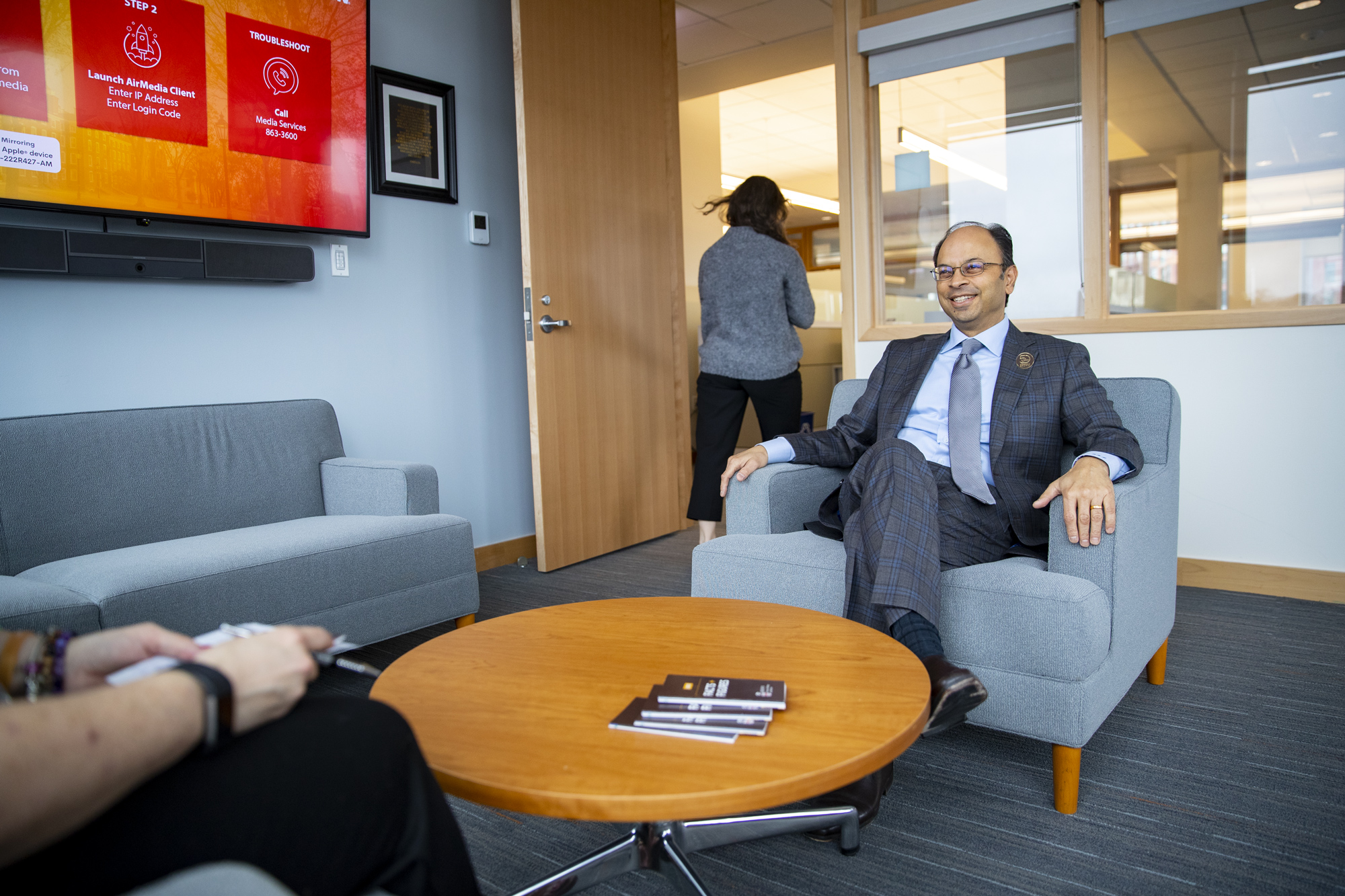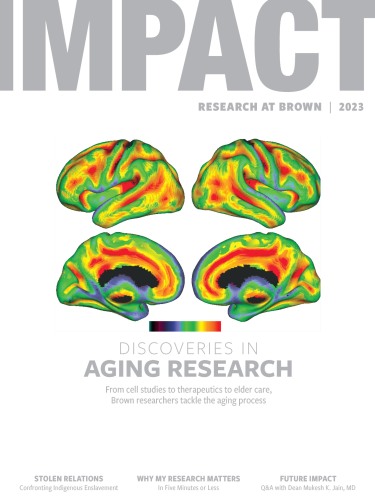Petri Dish, Patient, Population
Dean Jain leads Brown to a future of integrated biomedical research
Finding a shared North Star for Brown, Lifespan, and Care New England during his first year at Brown, Dean Jain looks forward to integrating their research activities and benefiting patients in the Providence community and beyond.
A conversation with Mukesh K. Jain, MD, Brown’s senior vice president for health affairs, dean of medicine and biological sciences, and professor of medicine, molecular biology, cell biology, and biochemistry.
Since Mukesh K. Jain, MD became dean of the Division of Biology and Medicine in March 2022, he has been partnering with everyone within Brown and its affiliated health systems to define the future of biomedical research.
At Brown, Dean Jain is identifying areas of research strength; building an integrated biomedical ecosystem with Brown’s Warren Alpert Medical School, School of Public Health, and School of Engineering; and expanding opportunities for trainees to seek dual careers as physician-scientists. He’s recruiting faculty in the areas of RNA, aging, cancer, brain science, and immunity and working to attract biotech and biopharma companies to the state.
In the community, his leadership brought what had long been a hazy, ambitious hope at Brown into clear and connected focus: a signed agreement between Brown, Lifespan, and Care New England to align their research operations, a goal that had been elusive for more than 25 years. The agreement will allow physicians, scientists, and physician-scientists within Brown and the two health systems to collaborate more effectively to advance science and medicine.
In Rhode Island, along with colleagues at the medical school, he is working with congressional and academic leaders to develop programs for teachers and students from K–12 through postsecondary schools to ensure the long-term future of the state’s STEM workforce, focusing on students from backgrounds underrepresented in medicine and science.
Nationally, Dean Jain is spearheading a movement to sequence RNA, positioning Brown to become a leader in this next big wave of biomedical research.In a conversation with Impact, Dean Jain talks about the value of an integrated academic health system, the vital role of physician-scientists, and Brown’s areas of research strength.
Q: You are a physician-scientist who specializes in cardiovascular medicine, a doctor who both treats patients clinically and engages in biomedical research. What impact do physician-scientists have on advances in modern medicine?
MKJ: Physician-scientists are individuals who see patients, identify unmet challenges in medicine, and then come back to the research setting to try to gain fundamental insights. Then, on the basis of those discoveries, physician-scientists seek to develop new interventions, new diagnostics, and new therapeutics to improve human health. We commonly refer to this virtuous cycle as “bedside-to-bench-and-back” research to advance human health.
Q: You were trained as a physician-scientist during your postgraduate studies. Did you immediately begin to utilize this training in your work?
MKJ: Yes. When I was going through my medical training, I became interested in cardiology. At that time, there was a lot of excitement in the field derived from clinical observations that there was a link between obesity and cardiovascular disease. The main question at the time was whether this was all about lipids, or was there something else going on? Clinical evidence was emerging that vascular disease states such as atherosclerosis, which leads to heart attacks, gangrene of the extremities, and strokes, were not just caused by bad cholesterol. The missing link was identified to be inflammation. Today we talk about inflammation as being important in many, many diseases, particularly those associated with aging.
“ Our efforts led to the discovery of a family of genetic factors termed Krüppel-like factors (KLFs). We would go on to show that these factors coordinate the function of blood vessels, the immune system that regulates inflammation, and the metabolic system that regulates obesity. ”
The clinical observations I mentioned were instrumental in our work, which is quite basic and fundamental but led to a new field. Today there are hundreds of labs across the nation and globe studying novel functions of KLFs for their roles in diverse disease states.
Q: Will you continue this research at Brown?
MKJ: That is the plan, but I will acknowledge that it will not be easy, given my other responsibilities. Once upon a time, I had a lab of two dozen people. My lab today is three people, but we’re continuing our work. It was about 20 years ago when we discovered that family of genetic factors. A lot of our focus today, interestingly, is on how these factors control the very process of aging itself. We’re hoping to apply the knowledge we gain to impact cancer, cardiovascular disease, and dementia as age-associated disorders through collaborations with colleagues at Brown.
Q: The number of physicians engaged in research has been in decline nationally for many reasons—medical school debt, insufficient time for research, pressure to write grants, and stiff competition for research dollars, to name a few. Despite these challenges, one of your goals is to revive the physician-scientist. Why do we need more doctors who are scientists?
MKJ: Physician-scientists constitute about 1.5 percent of all physicians in the United States, and the numbers are declining. Think about a world without a Tony Fauci, the quintessential physician-scientist. He was an immunologist of great capability and rose to the highest levels to head the NIH’s Institute of Allergy and Infectious Diseases. Not only did he do great science and develop therapies, but he has served for decades as a pillar for public health advocacy.
Physician-scientists have developed therapies, devices, and technologies, and their discoveries have led to the creation of hundreds of the medications we use today. Seventy percent of the chief research leaders of Big Pharma are physician-scientists. More than one-third of Nobel laureates in medicine and physiology are physician-scientists. Yet they’re dwindling and becoming rare. So there’s a real challenge, and issues such as debt, low funding rates, and long training periods, among others, exacerbate the problem.
We’ve been very focused on trying to figure out ways to increase the numbers of physician-scientists. Along with four other colleagues (including two Nobel laureates), I started the Physician-Scientist Support Foundation to address some of those issues at the individual, institutional, and national levels and to increase the number of physician-scientists.
Q: You have suggested that medical schools and health systems work with other partners to address the challenge. What does such a collaboration look like, and how does it help solve the problem?
MKJ: Medical schools and health systems need to work together because we both share the view that physician-scientists are critical to our efforts to impact human health. I do not believe that everybody needs to be a physician-scientist. But we do need a critical mass, and that is being threatened today.
Also, people who identify as Hispanic, Black, or Native American make up just 5 percent of physician-scientists receiving NIH funding, so at the same time, we must ensure that we are preparing a diverse cadre of students for these careers. Health systems and medical schools working together can encourage and support trainees at multiple levels—students, residents, and fellows—to pursue this rewarding dual-career path.
Q: Describe your vision for a research collaboration with Lifespan and Care New England. Why would such a collaboration benefit the institutions, the broader biomedical ecosystem, and the Providence community?
MKJ: After more than 25 years and multiple failed efforts, we signed an agreement last year between the Warren Alpert Medical School, the School of Public Health, Lifespan, and Care New England to integrate our research activities. The name of this new structure is the Brown Innovation and Research Collaborative for Health, or BIRCH.
This integration across the entire research continuum—from petri dish studies in the laboratory to patients in clinical trials in the hospitals to population research that occurs in the School of Public Health—is very unusual nationally. We’re able to do it because of the collaborative culture and trust that’s been built in the last year. The School of Engineering is also part of this ecosystem, with areas such as biomedical engineering that are joint efforts between the medical and engineering schools.
This milestone moment for the Rhode Island community will have many benefits. First and foremost, we will be able to bring cutting-edge care to impact the lives of our community. This integration will also allow us to recruit the best and brightest, attract the biotech and biopharma industries, and enhance the community’s economic vibrancy and workforce opportunities.

Q: What are your plans for supporting the expansion of research activity across the Division of Biology and Medicine?
MKJ: We identified five areas where we have real strengths and capabilities. Aging and age-associated disorders, cancer, and brain health are three areas. The fourth is neglected tropical diseases—health challenges that aren’t important in our backyard but affect millions of the most marginalized citizens across the globe. One of the most wonderful aspects of Brown, the ethos of Brown, which is different from any institution I’ve been at, is the deep commitment to be a global citizen and do things for societal impact.
And fifth is an area of science that touches all diseases: RNA science and therapeutics, which is viewed as the next big wave to benefit human health. That wave is just starting, and we are investing very heavily in that space because we want to be leaders on the top of that wave. We’re establishing a new center and have recruited an international authority in this space who will be starting at Brown on July 1, 2023. We’re aggressively recruiting new faculty and engaging with biotech and biopharma companies that have an interest in RNA diagnostics and therapeutics.
We’re also deeply involved with the National Academies of Sciences, Engineering, and Medicine, helping to catalyze a movement to sequence RNA—the human RNome. This project is akin to the Human Genome Project but in size and scale many times larger. The efforts of the three academies are being funded by the NIH and the Warren Alpert Foundation, which has been very supportive of innovative research and education. They named the medical school with a $100 million gift in 2007 and, in a subsequent gift in 2016, established the Warren Alpert Physician-Scientist MD/PhD and Advanced Training Program.
“ What’s more, through our efforts in undergraduate biology education, we are exposing a much more diverse group of students to research with the goal of encouraging them to pursue related careers. That, in turn, will further diversify the research workforce. ”
Q: Why is the expansion of research so important to Brown’s undergraduate college students?
MKJ: Brown is one of the nation's oldest universities and is best known for providing an exceptional collegiate education. Every year, roughly 300 students graduate from an undergraduate biology program, and more than 400 students pursue a thesis, fellowship, independent study, and/or paid research with faculty in the Division.
We are increasing opportunities for undergraduate research not at the expense of education but to amplify the educational experience and better position our students for success. It is something they clearly desire, and the University’s commitment to expanding research for impact is aligned with the aspirations of our students. What’s more, through our efforts in undergraduate biology education, we are exposing a much more diverse group of students to research with the goal of encouraging them to pursue related careers. That, in turn, will further diversify the research workforce.
